The 8 millionth new energy vehicle from BYD rolled off the production line in Thailand, paving a new way for Chinese cars to go global!
 AshleyJul 05, 2024, 04:32 PM
AshleyJul 05, 2024, 04:32 PM
It took BYD 13 years to go from "the first new energy vehicle to the one-millionth new energy vehicle", but only 3 years to go from "one million to eight million".
On July 4, the 8 millionth new energy vehicle from BYD was off the line in Thailand factory. This was the first car to be off the line at the Thailand factory, and BYD thus became the world's first automotive brand to reach the off-line of the 8 millionth electrified vehicle.
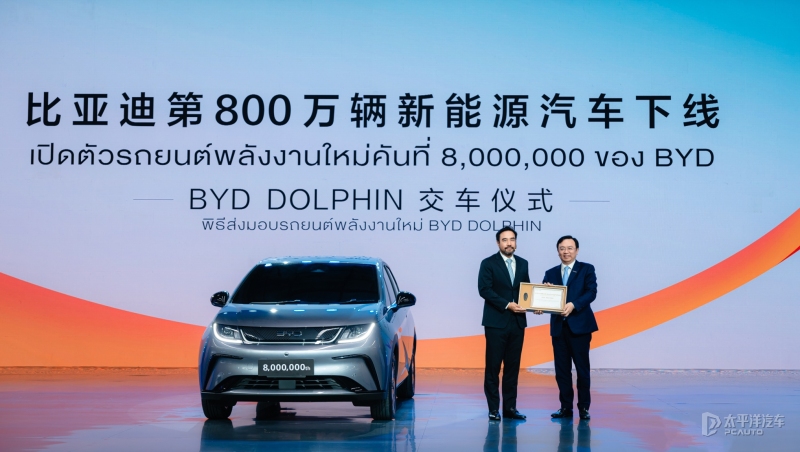
On the spot, Wang Chuanfu, Chairman and President of BYD, delivered the 8 millionth electrified vehicle DOLPHIN to Prince Dispanadda Diskul, CEO of the Queen Mother's Foundation of Thailand. "Since 2023, BYD has been leading the electric vehicle market in Thailand for 18 consecutive months. One in every three electric vehicles sold is BYD." On the stage, Wang Chuanfu, with a smile on his face, was introducing BYD's achievements in Thailand to media and customers at home and abroad.
Without a doubt, BYD has set a new paradigm for Chinese electric vehicles to go abroad from building a whole car to building a local factory.
1. From queuing for purchases to building local factories
On the afternoon of July 3, Xiong Tianbo, general manager of BYD's FANGCHENGBAO Business Department, posted a short video on Chinese social media and @ DENZA Sales Business Department general manager Zhao Changjiang. The caption: four missing one, hurry up. In the video, Xiong Tianbo, Hu Xiaoqing(general manager of YangWang sales business department), Zhang Zhuo(general manager of Ocean King sales business departmen) and Lu Tian(general manager of Dynasty Network sales business departmen) are pushing their suitcases and walking forward in a line, light-hearted and laughing. The BGM is Jacky Cheung's "Legend of the Hungry Wolf", the screen is quite impressive.
Netizens' comments were also very direct, "BYD Five Giants".

Activities that can mobilize these five people at the same time are obviously not simple, and they also demonstrate BYD's emphasis on this event. It is the completion of the BYD Thailand factory and the offline ceremony of the 8 millionth new energy vehicle. It takes only 3 hours to fly from BYD's headquarters in Shenzhen to Thailand. Allowing Chinese electric vehicles to be born in Thailand, started from the late 1990s when Chinese cars went overseas, it took nearly 30 years.
Thailand, almost the most familiar Southeast Asian country to Chinese people, is one of the must-visit destinations for many Chinese people's Southeast Asia tours. However, a few years ago, the streets here were still running Toyota, Mitsubishi, and other Japanese cars. In 2018, BYD brought electric taxis to Bangkok, Thailand. Since then, the streets of this Southeast Asian country have had Chinese electric vehicles. On November 1, 4 years later, BYD officially sold ATTO 3 in Thailand.
What is unexpected is that the night before the sale, Thai consumers lined up all night in front of several BYD stores in Bangkok to order BYD's electric vehicles. This scene can't help but remind people of the scene where domestic consumers line up all night to grab Apple phones. The scene of Thai users queuing up to grab BYD was called the "Thai Phenomenon" by local media. BYD only took 42 days to complete the first 10,000 sales in Thailand with a new car brand and one model. Speaking of this past, Liu Xueliang, the general manager of BYD Asia-Pacific Auto Sales Division, is proud.
In fact, since entering Thailand, BYD has always sold very well. In 2023, BYD's annual registration volume in Thailand reached 30,650 units, becoming the sales champion of pure electric vehicles in Thailand for the year, and the brand market share exceeded 40%. From January to May 2024, BYD's cumulative registration volume in Thailand reached 12,895 units, and the proportion of pure electric vehicles reached 40.5%. Among the top 4 best-selling pure electric models in Thailand, BYD has 3. Although the whole vehicle sells very well, BYD is not satisfied with this, but has a longer-term vision and plan. In fact, in the few months before BYD sold ATTO 3 in Thailand, BYD decided to build a factory in Thailand.
In March last year, the foundation ceremony of the Thailand factory was held. Just 16 months later, the factory officially started production, which created the fastest production record for Chinese auto companies invested in Thailand.
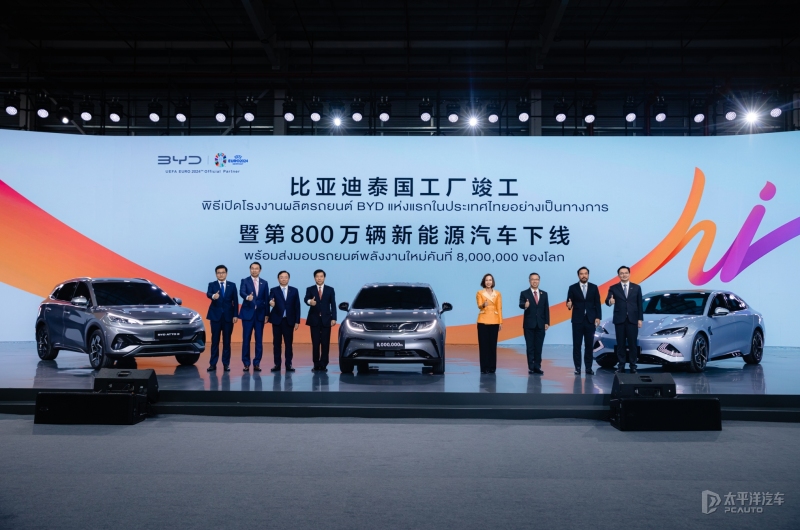
The Thailand factory is the first overseas passenger car factory wholly invested and built by BYD, with an annual capacity of 150,000 units. At the completion ceremony of the BYD Thailand factory and the 8 millionth new energy vehicle coming off the assembly line, Wang Chuanfu was in high spirits. He said that the annual output of BYD Thailand factory is 150,000 units, including the four major vehicle processes and parts factories, which can provide about 10,000 jobs after reaching full production. The models produced by the Thailand factory are mainly sold to Thailand and the surrounding ASEAN countries.
Wang Chuanfu also revealed that in the future, BYD will introduce more pure electric car models in Thailand, will also introduce plug-in hybrid car models, and achieve localized production to promote the transformation and upgrade of Thailand's automotive industry chain.
2. Chinese Automobile Manufacturers Compete in Thailand
Albeit BYD's sales figures are the most eye-catching in Thailand, it is not the only Chinese car brand that has set up a factory in Thailand. Just three days ago, GAC-AION also announced that its Thailand Intelligent Ecological Factory will be officially completed in mid-July, and the second-generation AION V will also be launched globally. In recent years, domestic car companies have intensified their competition, and going overseas has become an inevitable choice for Chinese car brands. Just like Chinese tourists are most keen on Southeast Asian tourism, close at hand Southeast Asia has become a bridgehead for Chinese cars to go overseas. And Thailand, with its geographical and policy advantages, has become the bridgehead within the bridgehead.
Including BYD, GWM, CHANGAN, SAIC, and GAC have subsequently established local factories, with total investments reaching billions of dollars. Unlike BYD's new factory mode, GWM purchased a general factory and upgraded it in 2020, immediately launching the locally popular HAVAL H6 electric car.
Following suit, ChanGAn invested $300 million to build a factory in Thailand, specifically to produce right-hand drive models. SAIC also took action, joining hands with Thailand's well-known company Charoen Pokphand Group to establish an industrial park focusing on the production of new energy parts in Thailand.
Why are Chinese auto companies flocking to build factories in Thailand? The answer might be in these eight words: "whoever gets Thailand gets Southeast Asia." Thailand is ASEAN's largest car manufacturing country, known as the "Detroit of the East". Its automotive industry chain is highly developed, with about 700 first-tier parts suppliers. At the same time, Thailand is also ASEAN's largest car exporting country, with an annual export volume of up to 2.5 million units.
Geographically, Thailand is located in the center of Southeast Asia, which can effectively radiate the entire Southeast Asia region. It is an important hub connecting Asia and Oceania, and is even the gateway to the entire Southeast Asian market. Based in Thailand, Chinese car companies can take advantage of Thailand's geographical advantages to further radiate to the ASEAN market with a population of 600 million. From this point of view, Chinese auto companies' investment in Thailand is not only to seize the Thai electric vehicle market but also to use Thailand as a springboard to enter the huge Southeast Asian market with a population of 600 million. Once they take the Thai market, the Southeast Asian market is just around the corner.
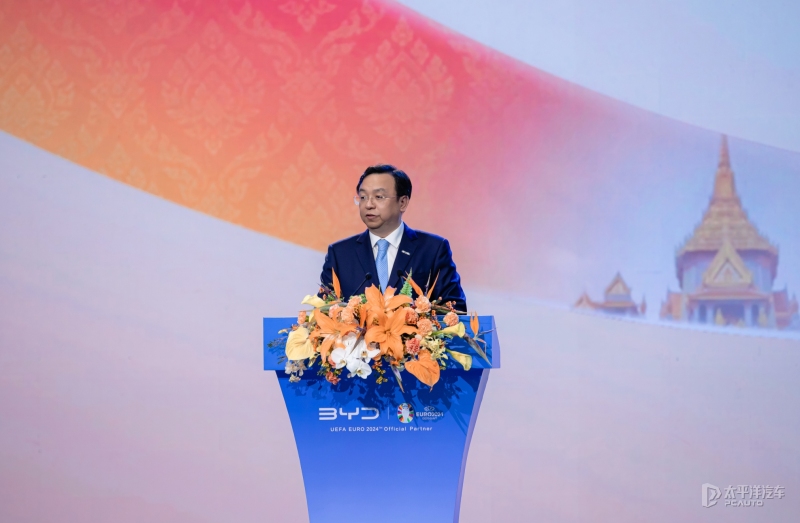
Wang Chuanfu judged that Thailand is ushering in a golden period of development for new energy vehicles. He said that from 2021 to 2023, the sales volume of pure electric vehicles in Thailand has increased by nearly 40 times, and the penetration rate of pure electric vehicles has increased from less than 1% at the beginning of 2021 to the current 12%. Referring to the development experience of the Chinese market, when the penetration rate of new energy vehicles breaks the 10% threshold, it will usher in leapfrog development.
Wang Chuanfu's judgement was also confirmed by the Thai government. The Thai government has already proposed a goal of reaching an annual production volume of 750,000 electric vehicles by 2030, accounting for 30% of Thailand's total automobile output. In addition, the Thai government plans to allocated 40 billion Thai Baht from 2023 to 2025, mainly to provide subsidies to car buyers, striving to achieve a capacity of 1.2 million electric vehicles by 2036. According to forecasts, the scale of the new energy vehicle market in Southeast Asia will grow from 38,000 in 2020 to 1 million in 2030. It can be seen that both Thailand and the whole of Southeast Asia have great potential. The fact that BYD is setting up factories and production at this time is undoubtedly a good opportunity.
3. New Paradigm of BYD's Overseas Expansion
Although BYD's Thai factory has attracted a lot of attention, it is actually one piece in the puzzle of BYD's grand overseas construction plan. In Southeast Asia alone, in January this year, BYD announced an investment of 1.3 billion USD to build a factory in Indonesia with an annual production of 150,000 automobiles. This is the second factory that BYD have announced in overseas investment in the past two months. Moreover, just one week before the first car rolled off the production line at BYD's Thailand factory, the first SONG PLUSDM-i champion edition electric vehicles were officially launched at the BYD Uzbekistan factory. On the day of the event, even President Mirziyoyev of the Republic of Uzbekistan visited the factory, which shows the importance placed on BYD.
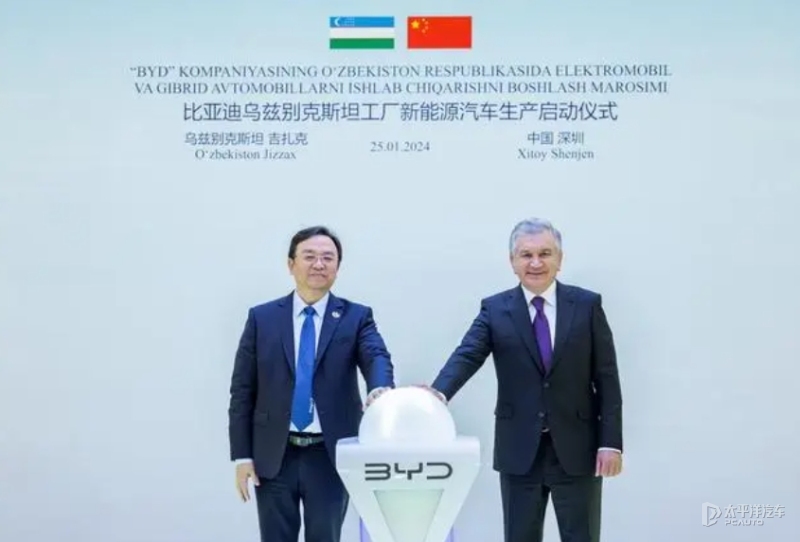
Compared to the low-profile BYD Uzbekistan factory, BYD's Hungary factory has frequently appeared in the news recently. The China-friendly Hungarian Prime Minister Orban praised BYD as the world's largest electric vehicle manufacturer, and it will establish its first European car factory (passenger car) in Hungary. At present, the factory has started construction and is expected to be completed and put into production in 2025, producing batteries and complete vehicles.

In addition to Asia and Europe, BYD has also turned its eyes to the Americas. Just a year ago, BYD and the Government of Bahia State in Brazil jointly announced that they would establish a large-scale production base complex composed of three factories in Camacari City, with a total investment of R$3 billion, which plans to be put into production in the second half of 2024. The Brazilian production base complex includes a production factory mainly engaged in electric buses and truck chassis, a new energy passenger vehicle assembly plant, and a processing plant dedicated to lithium iron phosphate battery materials. Among them, the new energy passenger vehicle assembly production line covers pure electric and plug-in hybrid models, with an annual production capacity planned to reach 150,000 units.
Of course, this is not the whole of BYD's overseas factory building plan, there are traces of BYD in places like Morocco, India. At present, BYD's total planned overseas production capacity has exceeded 1 million units/year, covering 34% of BYD's total sales, and overseas investment in factory construction has an accelerating trend. With the boost of vehicle exports and overseas factory construction, BYD's overseas sales reached 203,400 units in the first half of this year, which is close to 243,000 units for the whole of last year. In 2024, BYD's overseas sales target is 500,000 units, and the sales target for 2025 is 1 million units, with the plan to double in the next three years.
To achieve this goal, building factories overseas is a necessity. At the end of last year, Zhang Yongwei, the deputy director and secretary-general of the China Electric Vehicle 100 People's Association, stated at a media communication meeting that there are mainly two ways for automobile internationalization. One is export trade, and the other is local investment, production, and sales. He believes that in 3024, Chinese automobile internationalization will still maintain a fast-growing trend of both trade and overseas production, which will gradually change from trade-oriented to overseas investment and localized development.
Obviously, BYD is at the forefront of this international trend that setx a new model for Chinese new energy vehicles to go global.
4. Conclusion: It's better to go global than to be involved in internal competition
Currently, "internal competition" has become a buzzword and main theme in the domestic car market. Some automakers even want to defeat their competitors completely in order to stay in the game. Some are so desperate to win that they even fall out completely. However, price wars and fall out are definitely not the panacea to eliminate internal competition, but will only lead to a lose-lose situation, and increase the internal consumption of Chinese cars. Going global is the best way for Chinese cars to get out of the internal competition.
Going global not only provides a broader market, but also brings higher profits. For example, the starting price of BYD ATTO 3 in the European market is 37,990 euros, 148.5% higher than its starting price of 119,800 RMB in the Chinese market. The recommended retail price of CHERY OMODA 5 in the UK is 24,000 pounds, a premium of 180% over the domestic price of 79,900 RMB. The price of NIO ES6 in Germany ranges from 65,500 to 74,500 euros, 54% higher than the domestic price in China.
Of course, going global is not always smooth. Beneath the magnificent waves, there are still many challenges. On the day when BYD's Thai factory was completed and the 8 millionth new energy vehicle was produced, the European Commission announced that after nine months of anti-subsidy investigations into Chinese electric vehicles (BEV), it decided to impose temporary anti-subsidy taxes on imports of electric vehicles from China. These include 17.4% for BYD, 19.9% for GEELY, and 37.6% for SAIC. Other cooperating but unelected Chinese manufacturers will be charged a weighted average duty of 20.8%.
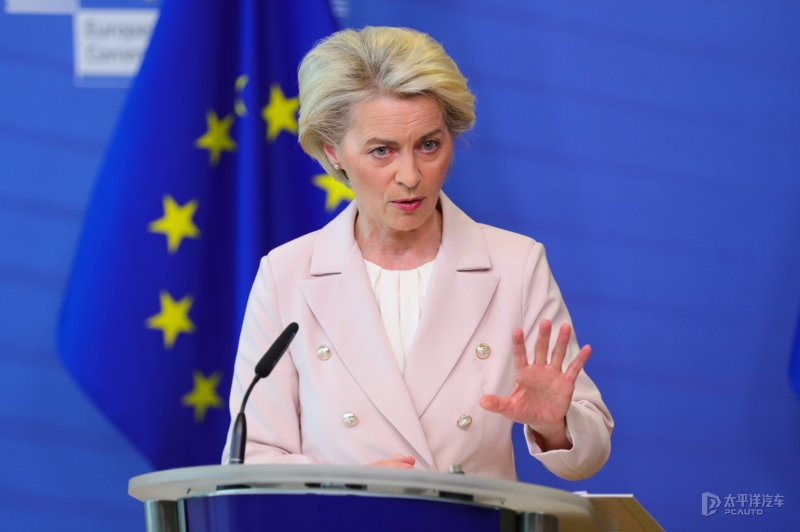
Not only the EU, but in May this year, the US government announced a significant increase in import tariffs on Chinese-made electric vehicles from 27.5% to 102.5%. Subsequently, Canada claimed that it might also increase tariffs on Chinese electric cars. In fact, even countries like Turkey have imposed high tariffs on Chinese electric vehicles to slow down the pace of Chinese electric vehicles going overseas.
At present, the prospect of Chinese cars going overseas is not optimistic, especially electric vehicles are facing huge challenges. This is because the global car market only has over ten million: China, Europe and the United States. Further down, there are India, Japan, ASEAN and South America.
Obviously, North America and Europe have basically closed their doors to Chinese electric cars. The demand for electric vehicles in the Indian and Japanese markets is not large, and the market share accounts for only 2% of the ratio. Moreover, the two major markets of Japan and India are relatively closed, and it is not easy for Chinese electric vehicles to get in.
Under the heavy tariff barriers, building factories locally has become a way to break the deadlock. Just like Japanese car companies that built factories in the United States 40 years ago, Chinese cars are also going to build cars closer to local consumers.
BYD also has a deep insight into the situation. Before the completion of the Thai factory, BYD released an official propaganda film "Chinese Brands, the Harder the Greater the Courage". The film reminisces about the difficult past and brilliant achievements of Chinese brands going overseas. One of the memorable quotes in the film is: "When you encounter difficulties, conquer them with determination. When faced with obstructions, break them with persistence. No matter how formidable the obstacles, we can find our own way. The 5000 years of historical heritage is the confidence to tread the waves."
Obviously, BYD is this brave one who breaks the deadlock. Beside him, there are more and more Chinese car brands going overseas. Together, they will blaze a new trail for Chinese cars going overseas.
If any infringement occurs, please contact us for deletion
Trending News

Toyota Tundra Owner Achieves the Second Million-Mile Milestone
[PCauto] The mileage often measures the quality and durability of a car, and Victor Sheppard and his two Toyota Tundra pickups have set a staggering record.With Victor Sheppard's dedication and careful maintenance of the Toyota Tundra, he successfully drove two different Tundra pickups over 1 million miles (approximately 1,609,340 kilometers).In 2007, Sheppard bought a brand new Toyota Tundra CrewMax. Over the next nine years, as a contractor, he worked across the United States, from Louisiana t

BYD Plans to Promote 1000V High Voltage Super Charging Stations and Its Models on a Large Scale
【PCauto】Recently, the news that BYD plans to massively implement a 1000V high-voltage supercharging platform has attracted widespread attention. It is reported that this platform will be launched in the middle of March this year and supports super-fast charging above 5C. After its release, it will quickly be popularized to its own models and large-scale construction of 1000V supercharging stations.This move will undoubtedly set off a wave in the new energy vehicle market. Let's delve into the te
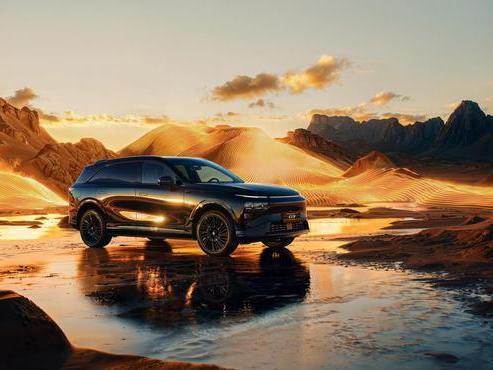
XPENG G9 is about to be launched in China, bringing 66 upgrades in features
【PCauto】XPENG has recently announced that the 2025 XPENG G9 will soon be launched in China. Although the official did not announce the time and price, the success of XPENG G6 and X9 has rekindled expectations for the once-failed G9 by XPENG. In terms of appearance, the G9 continues the X-BOT FACE 3.0 design language, with a closed grill at the front paired with split-style headlights on both sides, new two-tone collision colors and all-black body styles, with a petal-style wheel hub. Combining
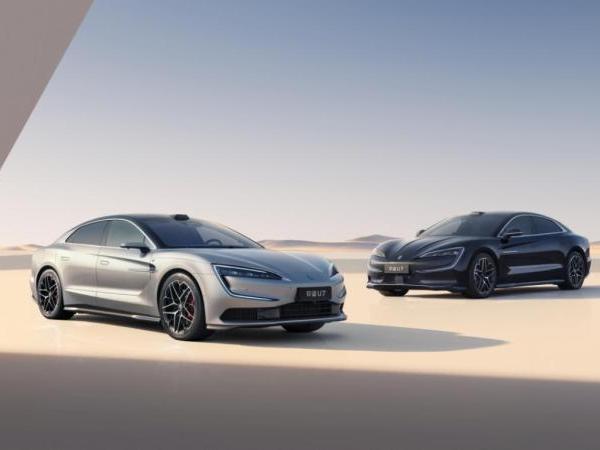
BYD YANGWANG U7 Launches with World's First Suspension Charging Tech
[PCauto] On March 27, BYD YANGWANG U7 was launched, with two power versions of pure electric and plug-in hybrid, a total of four models. YANGWANG U7 EV Five-seater Luxury Edition, priced at about 292.85 million baht/RM38.31 YANGWANG U7 EV Four-seater Flagship Edition, priced at about 330.04 million baht/RM43.19 YANGWANG U7 PHEV Five-seater Luxury Edition, priced at about 292.85 million baht/RM38.31 YANGWANG U7 PHEV Four-seater Flagship Edition, priced at about 330.04 million bah
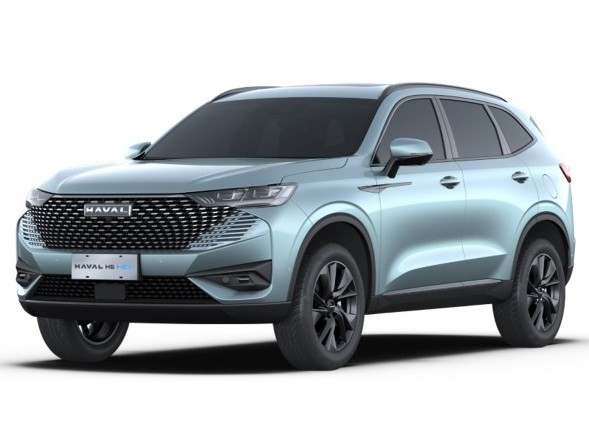
HAVAL H6: A Balanced Performer and a Reliable Choice for Family SUVs
Price of HAVAL H6HAVAL H6 has a total of 1 submodel.• 2024 HAVAL H6 HEV priced at RM 139,800Driving experience of the HAVAL H6As for the power, the HAVAL H6 is equipped with a 1.5L 4-cylinder turbocharging source, delivering a maximum power output of 110 kW and a peak torque of 230 N·M, with maximum torque available at 1500-4000 rpm. The power is transmitted to the Front Wheel via an AT transmission, achieving a combined fuel consumption of 5.8 L/100km. This p
Popular Cars
Car Compare

